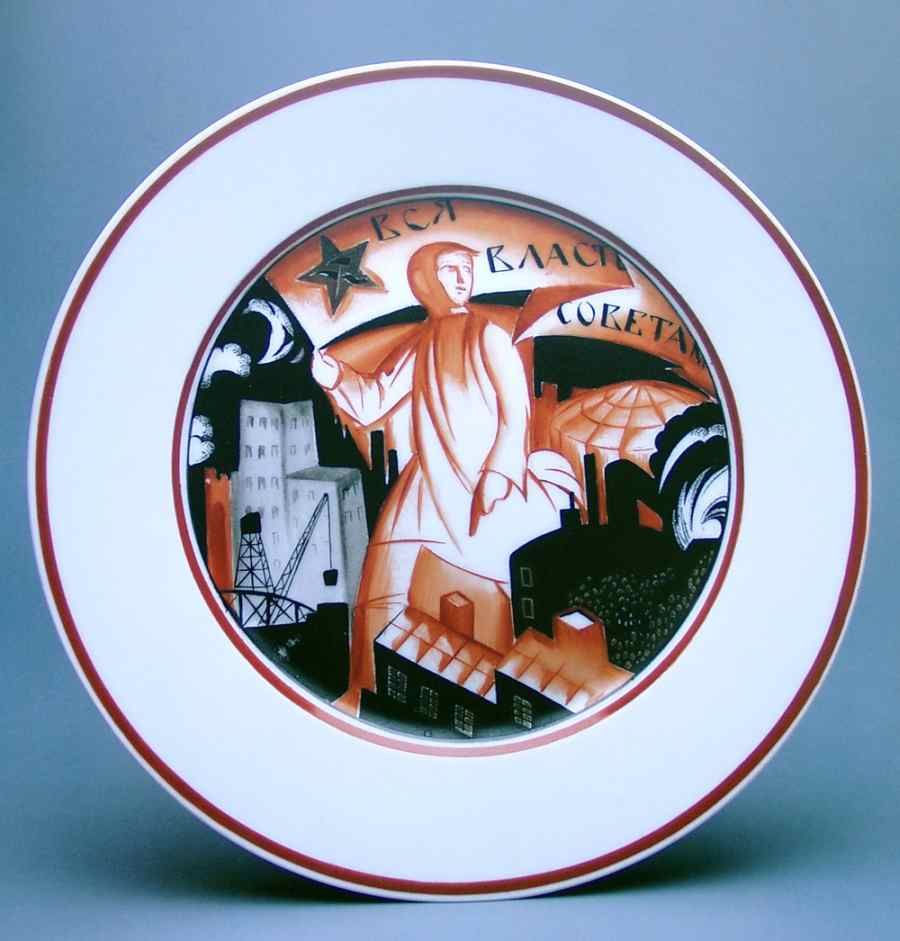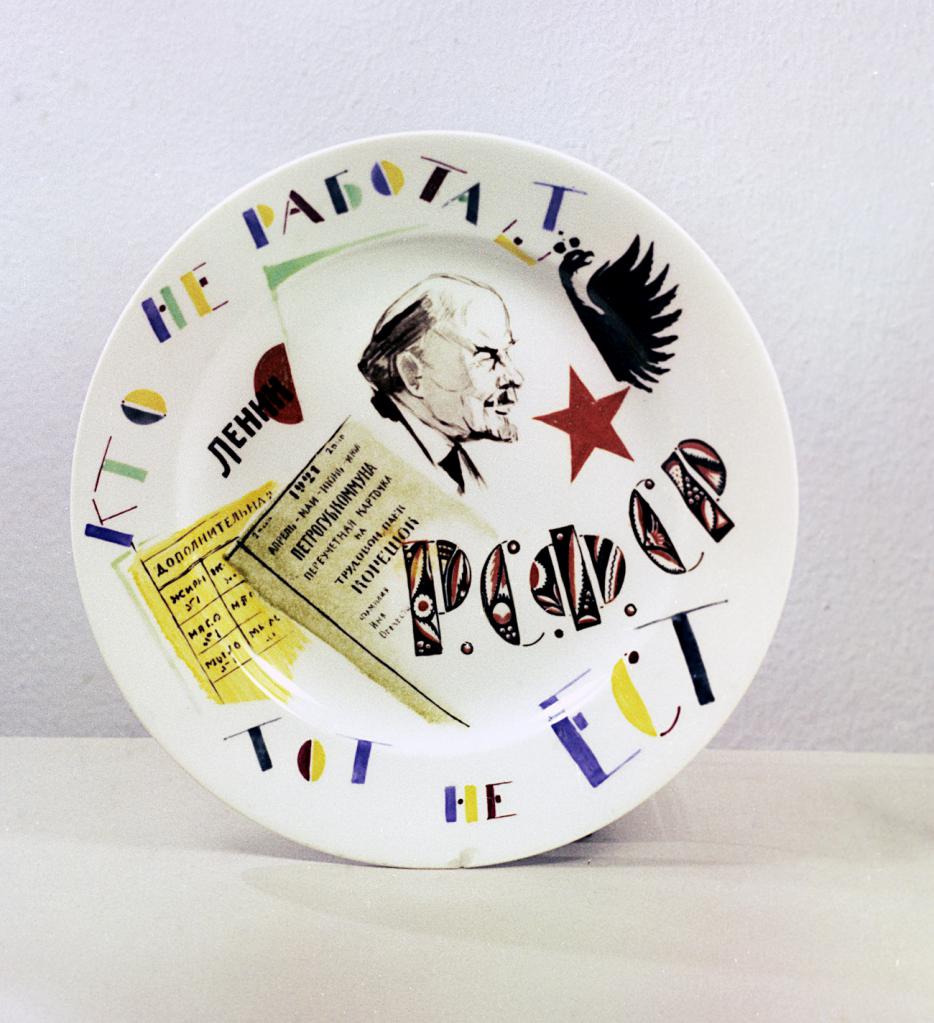The October Revolution of 1917 is an event that shocked the whole world. The triumph of the proletarian style was manifested in public life, art, industry. At this time, the process of creating a completely new culture, which included many representatives of the creative intelligentsia, begins.
How did Soviet agitation china come about?
At the beginning of the 20th century, the history of Russian porcelain is more than ever closely linked to the political situation. The attention of party leaders and creative personalities is also focused on the production of white clay products. The State Porcelain Factory, which was located in Petrograd, is turning into the main center of ceramics in the country. In 1918, it was headed by S.V. Chekhonin, a famous book graphic artist and one of the best specialists in his field.

Interested in the ideas of the revolution and overwhelmed by a thirst for activity, he dreams that the products of the plant should be included in the propaganda of the coup. In this the master, who became the founder of Soviet agitation china, sees the novelty of creative expression. Chekhonin is developing a new style based on a combination of images and inscriptions explaining them. It was a rather original way of propaganda of the values of the proletariat along with a poster - another advanced art. So a significant event is born for our country.
Revolutionary slogans and political drawings
In the autumn, tableware with revolutionary symbols and slogans appeared, and the factory itself, which had previously manufactured products for the royal court, was transferred to the People’s Commissariat as a testing laboratory of republican significance. Immediately he receives an order for the manufacture of busts of great men of our time and decorative objects with revolutionary slogans.

The first product on a given topic is a huge jubilee dish, made according to a drawing by the head of the plant with the coat of arms of the RSFSR. The distinctive sign of the new socialist state shines with gold on a black background. Porcelain turns into an elitist material, the shape of which is perfect, and the execution is impeccable. Miniature sculptures, mural paintings with photographic accuracy depict everything that happens in life. Revolutionary slogans and drawings, on which scenes of a new life flaunted, Soviet emblems - all this was addressed to all people, and not to individual connoisseurs of beauty. Soviet agitation china, born of the revolution, was a real conductor of the ideas of the Bolsheviks.
Novelty of subjects
New artists come to the plant, confident that breaking the old is necessary, including the need to replace not only people's ideas, but also the objective world surrounding them. However, the novelty of the topic brings a lot of trouble: difficulties are associated with the fact that you have to work on photographs and portraits. An unusual technique requires new means of expression. And soon, agitation porcelain approaches the graphic art of a political poster.
The dishes are decorated in an unusual style, and the painting on it becomes more vivid. The text woven into the ornament is combined with the Soviet emblem - the images of the sickle and hammer. Plates are issued with portraits of V. Lenin, K. Liebknecht, R. Luxembourg, and the Decembrists. Porcelain sculptures appear, depicting people serving the cause of the revolution - sailors and Red Guards.
Products not for the general public
Initially, it was assumed that propaganda porcelain would be available to all sectors of society, and people who develop a great taste will be drawn to the beautiful. However, it so happened that the unique products that capture what is happening do not reach customers, settling in the bins of collectors. The real excitement begins on the antique market, and hunters for masterpieces buy at auction items whose prices soar several times. So china becomes a new revenue item for the young state.
It is available in a limited edition, and only some of the products go on sale.
A new kind of proletariat art
In the 20s of the last century, porcelain, whose artistic merits were undeniable, visited international exhibitions, causing admiration for visitors. It is no coincidence that foreign journalists wrote that the revolution found its best reflection in the agitation china of the USSR. Experts praised the skill of artists, calling their work "a new type of proletarian art."
But in the country, products of this kind, the collection attractiveness of which is obvious to contemporaries, were exhibited only behind glass, in street windows on the main streets of Moscow and Petrograd, where people always crowded.
Production stop
But already in the 40s, ceramic production ceased. Campaign paintings are a thing of the past, and their place is occupied by plastic porcelain.
Due to increased demand, some factories continue to produce plates with political slogans, but their quality leaves much to be desired. And for collectors they are of no interest.
Dulevo porcelain: style and sophistication
One of the significant centers for the production of porcelain was the factory in Dulevo near Moscow, which was founded by Terenty Kuznetsov. In 1918, it was nationalized, and craftsmen began to master domestic raw materials and new technologies. Revolutionary themes become the sole content of the painting of products in which political slogans are unthinkable without external beauty.
Soon, agitation porcelain from Dulevo appeared - plates with the emblem of the USSR, which were never intended for use in everyday life. Rare in beauty products were created by craftsmen brought up in the traditions of the past. The revolutionary severity of the agitation tasks was neutralized by the sophistication of the previously established style.
The products of the plant of that time are always in the center of attention of famous London auctions.
Items that collectors hunt for
The phenomenon, analogues of which are not observed in world history, is of great interest to contemporaries. Agitation porcelain is a mirror of culture, life and life of an entire era. Products reflecting the canons of art are extremely popular now. They are hunted by collectors who do not regret giving 4 thousand pounds for a painted plate, and all those who want to preserve memories and remember our history.
This is an expensive antique, which is a real work of art, and rarities have long been dispersed in private collections.